Consumer Behaviour Analysis Report: Sunscreen & Snack Bars
VerifiedAdded on 2022/12/02
|12
|3272
|334
Report
AI Summary
This report provides an in-depth analysis of consumer behavior, focusing on the decision-making processes behind purchasing sunscreen and healthy snack bars. It explores crucial aspects such as product attributes, the types of decision-making (rational/emotional), the level of decision-making (habitual, limited, or extensive), and perceived risks along with suitable risk-reduction strategies. The report also examines awareness sets, evoked-set strategies, and dominant decision-making rules. Furthermore, it offers specific recommendations for a sunscreen manufacturer planning to introduce a new product with a "Made for Australian conditions" claim and for a snack-bar brand aiming to implement a new eco-food label. The analysis incorporates both academic literature and insights from discussions with family, friends, and colleagues, providing a comprehensive understanding of consumer behavior in these product categories.
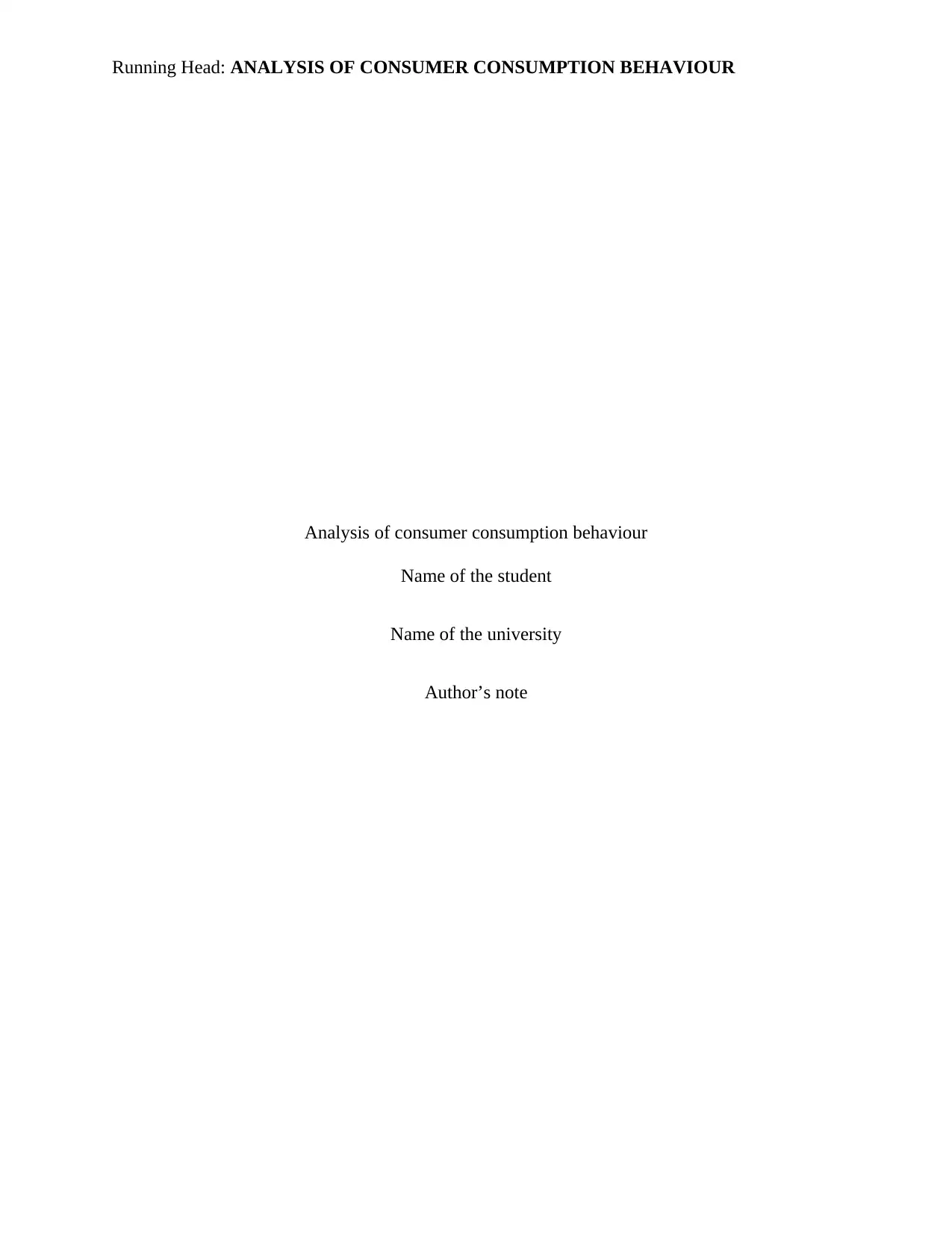
Running Head: ANALYSIS OF CONSUMER CONSUMPTION BEHAVIOUR
Analysis of consumer consumption behaviour
Name of the student
Name of the university
Author’s note
Analysis of consumer consumption behaviour
Name of the student
Name of the university
Author’s note
Paraphrase This Document
Need a fresh take? Get an instant paraphrase of this document with our AI Paraphraser
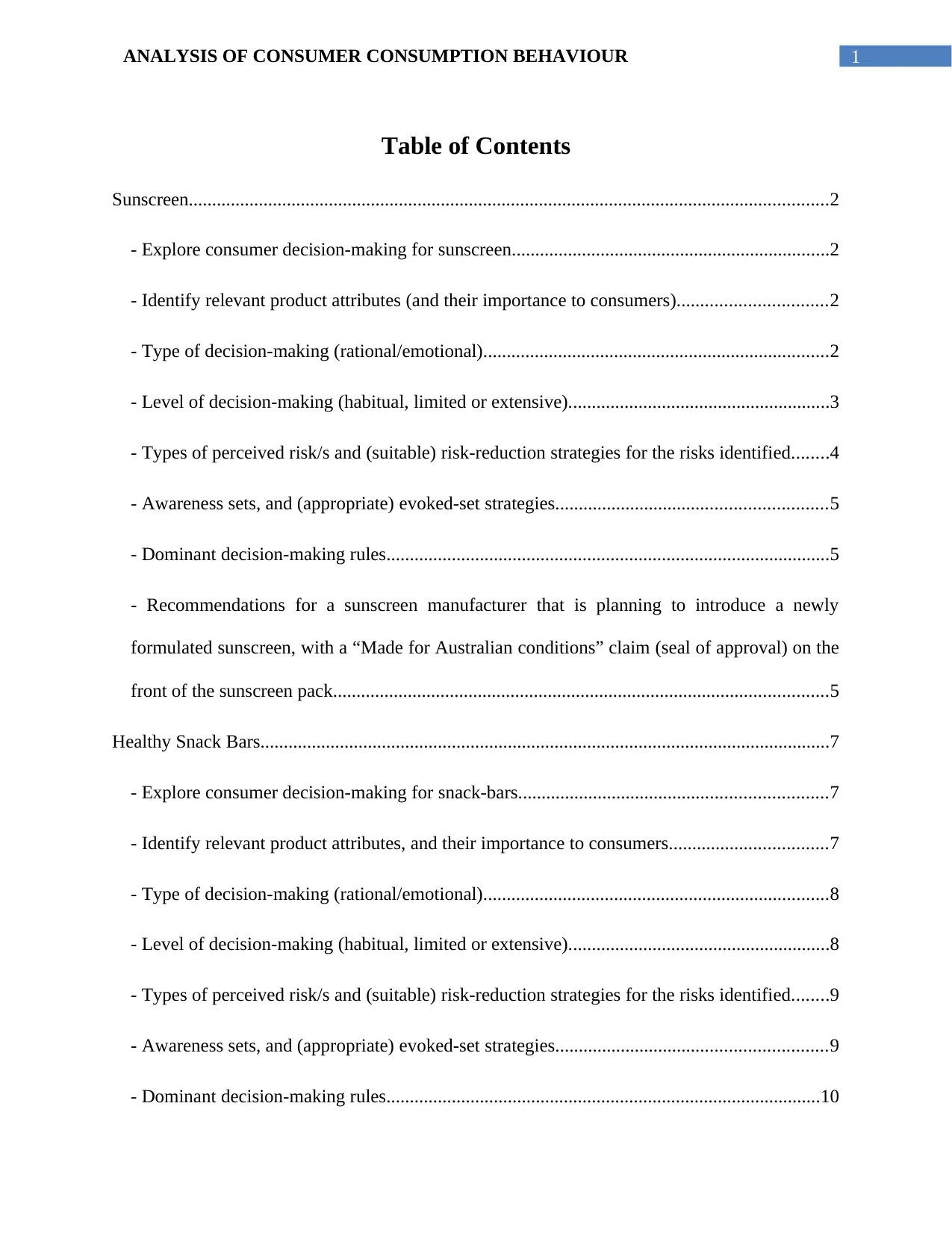
1ANALYSIS OF CONSUMER CONSUMPTION BEHAVIOUR
Table of Contents
Sunscreen.........................................................................................................................................2
- Explore consumer decision-making for sunscreen....................................................................2
- Identify relevant product attributes (and their importance to consumers)................................2
- Type of decision-making (rational/emotional)..........................................................................2
- Level of decision-making (habitual, limited or extensive)........................................................3
- Types of perceived risk/s and (suitable) risk-reduction strategies for the risks identified........4
- Awareness sets, and (appropriate) evoked-set strategies..........................................................5
- Dominant decision-making rules...............................................................................................5
- Recommendations for a sunscreen manufacturer that is planning to introduce a newly
formulated sunscreen, with a “Made for Australian conditions” claim (seal of approval) on the
front of the sunscreen pack..........................................................................................................5
Healthy Snack Bars..........................................................................................................................7
- Explore consumer decision-making for snack-bars..................................................................7
- Identify relevant product attributes, and their importance to consumers..................................7
- Type of decision-making (rational/emotional)..........................................................................8
- Level of decision-making (habitual, limited or extensive)........................................................8
- Types of perceived risk/s and (suitable) risk-reduction strategies for the risks identified........9
- Awareness sets, and (appropriate) evoked-set strategies..........................................................9
- Dominant decision-making rules.............................................................................................10
Table of Contents
Sunscreen.........................................................................................................................................2
- Explore consumer decision-making for sunscreen....................................................................2
- Identify relevant product attributes (and their importance to consumers)................................2
- Type of decision-making (rational/emotional)..........................................................................2
- Level of decision-making (habitual, limited or extensive)........................................................3
- Types of perceived risk/s and (suitable) risk-reduction strategies for the risks identified........4
- Awareness sets, and (appropriate) evoked-set strategies..........................................................5
- Dominant decision-making rules...............................................................................................5
- Recommendations for a sunscreen manufacturer that is planning to introduce a newly
formulated sunscreen, with a “Made for Australian conditions” claim (seal of approval) on the
front of the sunscreen pack..........................................................................................................5
Healthy Snack Bars..........................................................................................................................7
- Explore consumer decision-making for snack-bars..................................................................7
- Identify relevant product attributes, and their importance to consumers..................................7
- Type of decision-making (rational/emotional)..........................................................................8
- Level of decision-making (habitual, limited or extensive)........................................................8
- Types of perceived risk/s and (suitable) risk-reduction strategies for the risks identified........9
- Awareness sets, and (appropriate) evoked-set strategies..........................................................9
- Dominant decision-making rules.............................................................................................10
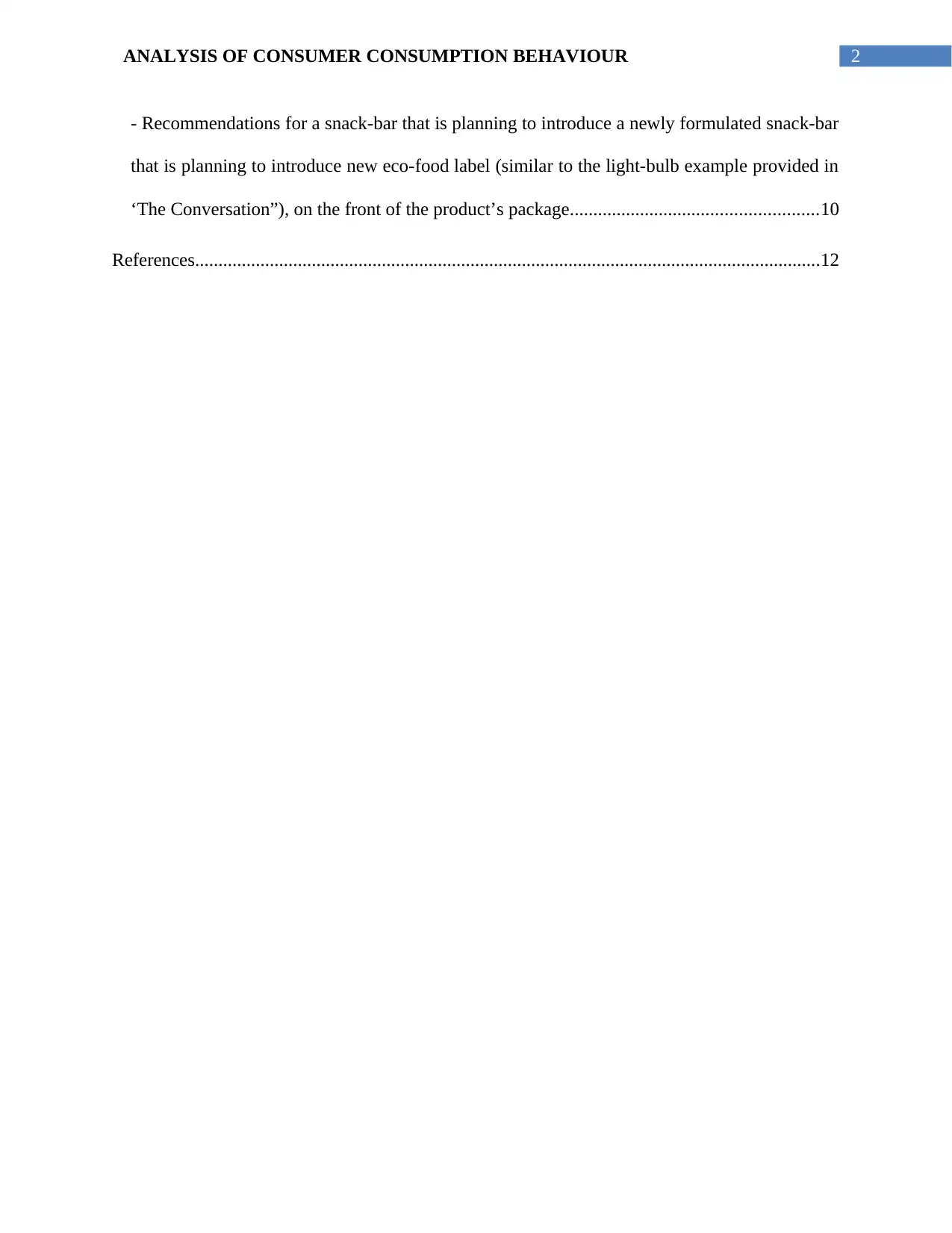
2ANALYSIS OF CONSUMER CONSUMPTION BEHAVIOUR
- Recommendations for a snack-bar that is planning to introduce a newly formulated snack-bar
that is planning to introduce new eco-food label (similar to the light-bulb example provided in
‘The Conversation”), on the front of the product’s package.....................................................10
References......................................................................................................................................12
- Recommendations for a snack-bar that is planning to introduce a newly formulated snack-bar
that is planning to introduce new eco-food label (similar to the light-bulb example provided in
‘The Conversation”), on the front of the product’s package.....................................................10
References......................................................................................................................................12
⊘ This is a preview!⊘
Do you want full access?
Subscribe today to unlock all pages.

Trusted by 1+ million students worldwide
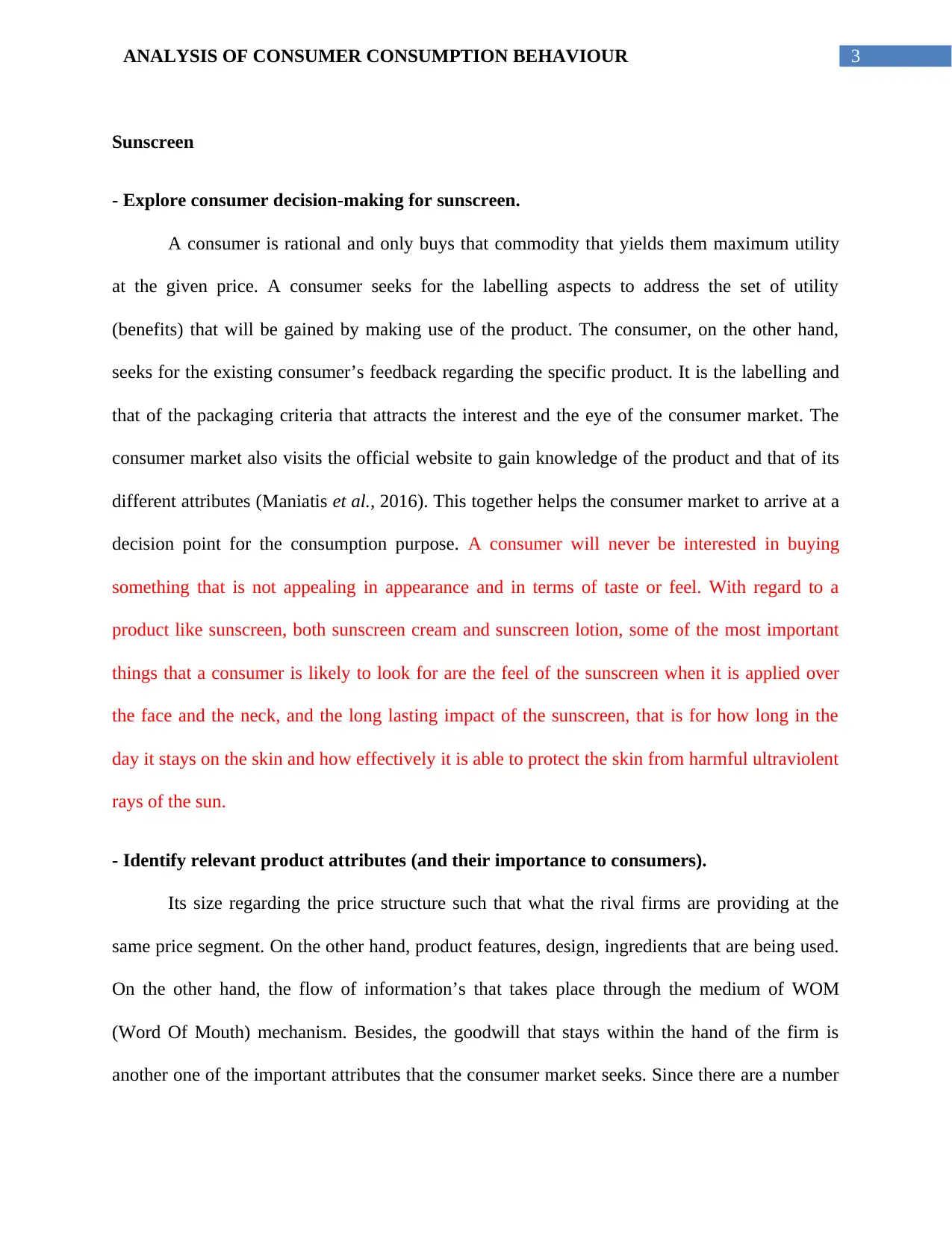
3ANALYSIS OF CONSUMER CONSUMPTION BEHAVIOUR
Sunscreen
- Explore consumer decision-making for sunscreen.
A consumer is rational and only buys that commodity that yields them maximum utility
at the given price. A consumer seeks for the labelling aspects to address the set of utility
(benefits) that will be gained by making use of the product. The consumer, on the other hand,
seeks for the existing consumer’s feedback regarding the specific product. It is the labelling and
that of the packaging criteria that attracts the interest and the eye of the consumer market. The
consumer market also visits the official website to gain knowledge of the product and that of its
different attributes (Maniatis et al., 2016). This together helps the consumer market to arrive at a
decision point for the consumption purpose. A consumer will never be interested in buying
something that is not appealing in appearance and in terms of taste or feel. With regard to a
product like sunscreen, both sunscreen cream and sunscreen lotion, some of the most important
things that a consumer is likely to look for are the feel of the sunscreen when it is applied over
the face and the neck, and the long lasting impact of the sunscreen, that is for how long in the
day it stays on the skin and how effectively it is able to protect the skin from harmful ultraviolent
rays of the sun.
- Identify relevant product attributes (and their importance to consumers).
Its size regarding the price structure such that what the rival firms are providing at the
same price segment. On the other hand, product features, design, ingredients that are being used.
On the other hand, the flow of information’s that takes place through the medium of WOM
(Word Of Mouth) mechanism. Besides, the goodwill that stays within the hand of the firm is
another one of the important attributes that the consumer market seeks. Since there are a number
Sunscreen
- Explore consumer decision-making for sunscreen.
A consumer is rational and only buys that commodity that yields them maximum utility
at the given price. A consumer seeks for the labelling aspects to address the set of utility
(benefits) that will be gained by making use of the product. The consumer, on the other hand,
seeks for the existing consumer’s feedback regarding the specific product. It is the labelling and
that of the packaging criteria that attracts the interest and the eye of the consumer market. The
consumer market also visits the official website to gain knowledge of the product and that of its
different attributes (Maniatis et al., 2016). This together helps the consumer market to arrive at a
decision point for the consumption purpose. A consumer will never be interested in buying
something that is not appealing in appearance and in terms of taste or feel. With regard to a
product like sunscreen, both sunscreen cream and sunscreen lotion, some of the most important
things that a consumer is likely to look for are the feel of the sunscreen when it is applied over
the face and the neck, and the long lasting impact of the sunscreen, that is for how long in the
day it stays on the skin and how effectively it is able to protect the skin from harmful ultraviolent
rays of the sun.
- Identify relevant product attributes (and their importance to consumers).
Its size regarding the price structure such that what the rival firms are providing at the
same price segment. On the other hand, product features, design, ingredients that are being used.
On the other hand, the flow of information’s that takes place through the medium of WOM
(Word Of Mouth) mechanism. Besides, the goodwill that stays within the hand of the firm is
another one of the important attributes that the consumer market seeks. Since there are a number
Paraphrase This Document
Need a fresh take? Get an instant paraphrase of this document with our AI Paraphraser
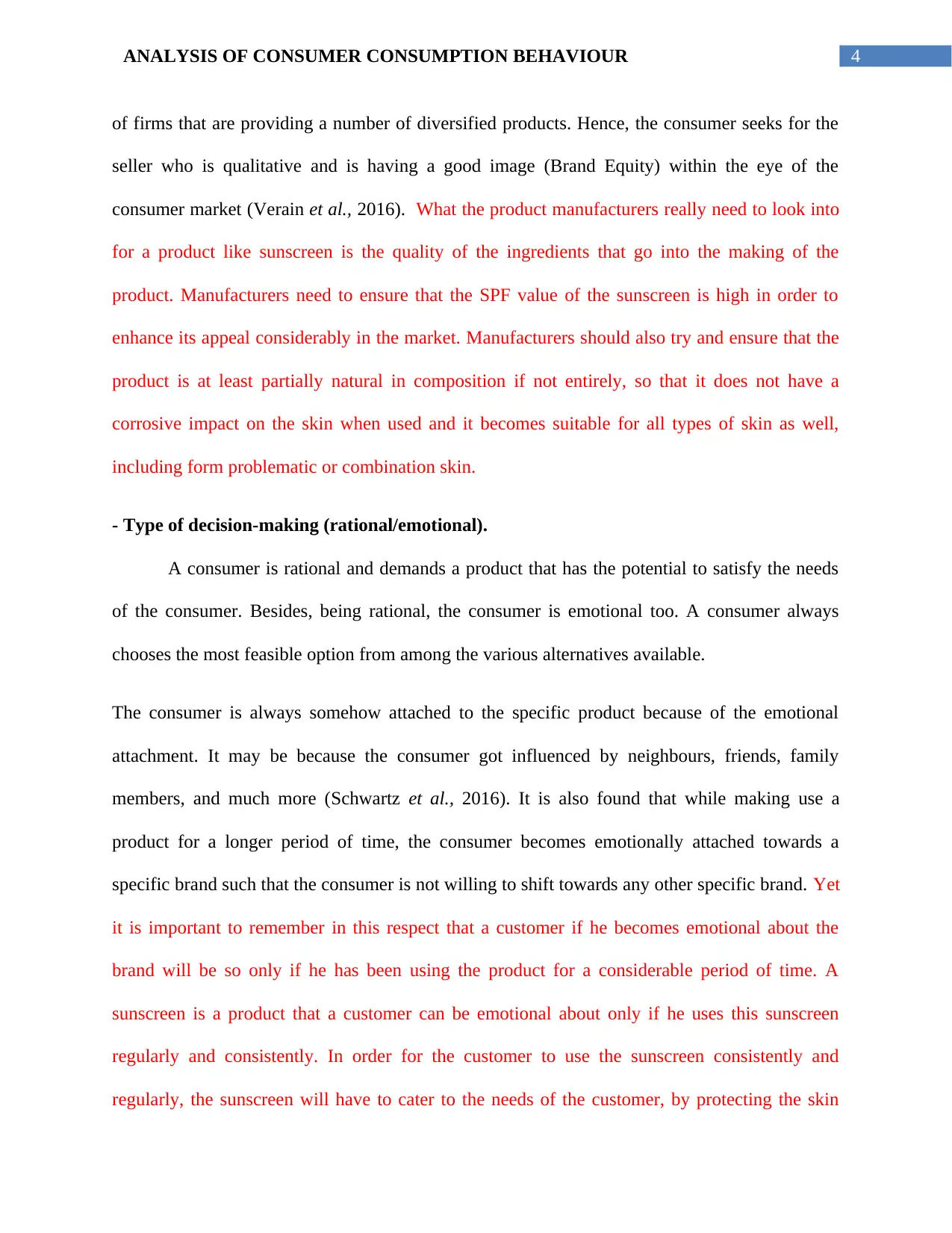
4ANALYSIS OF CONSUMER CONSUMPTION BEHAVIOUR
of firms that are providing a number of diversified products. Hence, the consumer seeks for the
seller who is qualitative and is having a good image (Brand Equity) within the eye of the
consumer market (Verain et al., 2016). What the product manufacturers really need to look into
for a product like sunscreen is the quality of the ingredients that go into the making of the
product. Manufacturers need to ensure that the SPF value of the sunscreen is high in order to
enhance its appeal considerably in the market. Manufacturers should also try and ensure that the
product is at least partially natural in composition if not entirely, so that it does not have a
corrosive impact on the skin when used and it becomes suitable for all types of skin as well,
including form problematic or combination skin.
- Type of decision-making (rational/emotional).
A consumer is rational and demands a product that has the potential to satisfy the needs
of the consumer. Besides, being rational, the consumer is emotional too. A consumer always
chooses the most feasible option from among the various alternatives available.
The consumer is always somehow attached to the specific product because of the emotional
attachment. It may be because the consumer got influenced by neighbours, friends, family
members, and much more (Schwartz et al., 2016). It is also found that while making use a
product for a longer period of time, the consumer becomes emotionally attached towards a
specific brand such that the consumer is not willing to shift towards any other specific brand. Yet
it is important to remember in this respect that a customer if he becomes emotional about the
brand will be so only if he has been using the product for a considerable period of time. A
sunscreen is a product that a customer can be emotional about only if he uses this sunscreen
regularly and consistently. In order for the customer to use the sunscreen consistently and
regularly, the sunscreen will have to cater to the needs of the customer, by protecting the skin
of firms that are providing a number of diversified products. Hence, the consumer seeks for the
seller who is qualitative and is having a good image (Brand Equity) within the eye of the
consumer market (Verain et al., 2016). What the product manufacturers really need to look into
for a product like sunscreen is the quality of the ingredients that go into the making of the
product. Manufacturers need to ensure that the SPF value of the sunscreen is high in order to
enhance its appeal considerably in the market. Manufacturers should also try and ensure that the
product is at least partially natural in composition if not entirely, so that it does not have a
corrosive impact on the skin when used and it becomes suitable for all types of skin as well,
including form problematic or combination skin.
- Type of decision-making (rational/emotional).
A consumer is rational and demands a product that has the potential to satisfy the needs
of the consumer. Besides, being rational, the consumer is emotional too. A consumer always
chooses the most feasible option from among the various alternatives available.
The consumer is always somehow attached to the specific product because of the emotional
attachment. It may be because the consumer got influenced by neighbours, friends, family
members, and much more (Schwartz et al., 2016). It is also found that while making use a
product for a longer period of time, the consumer becomes emotionally attached towards a
specific brand such that the consumer is not willing to shift towards any other specific brand. Yet
it is important to remember in this respect that a customer if he becomes emotional about the
brand will be so only if he has been using the product for a considerable period of time. A
sunscreen is a product that a customer can be emotional about only if he uses this sunscreen
regularly and consistently. In order for the customer to use the sunscreen consistently and
regularly, the sunscreen will have to cater to the needs of the customer, by protecting the skin
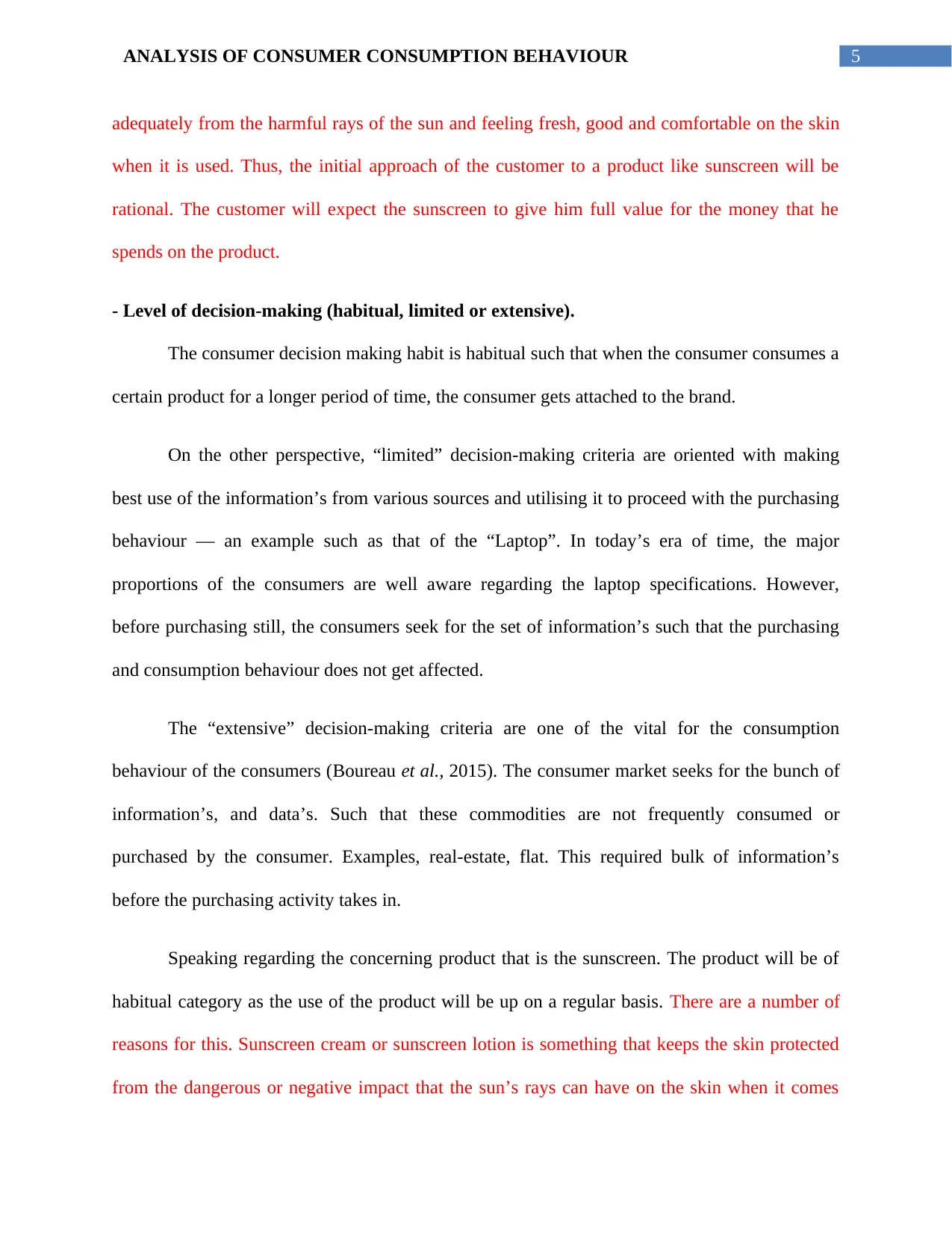
5ANALYSIS OF CONSUMER CONSUMPTION BEHAVIOUR
adequately from the harmful rays of the sun and feeling fresh, good and comfortable on the skin
when it is used. Thus, the initial approach of the customer to a product like sunscreen will be
rational. The customer will expect the sunscreen to give him full value for the money that he
spends on the product.
- Level of decision-making (habitual, limited or extensive).
The consumer decision making habit is habitual such that when the consumer consumes a
certain product for a longer period of time, the consumer gets attached to the brand.
On the other perspective, “limited” decision-making criteria are oriented with making
best use of the information’s from various sources and utilising it to proceed with the purchasing
behaviour — an example such as that of the “Laptop”. In today’s era of time, the major
proportions of the consumers are well aware regarding the laptop specifications. However,
before purchasing still, the consumers seek for the set of information’s such that the purchasing
and consumption behaviour does not get affected.
The “extensive” decision-making criteria are one of the vital for the consumption
behaviour of the consumers (Boureau et al., 2015). The consumer market seeks for the bunch of
information’s, and data’s. Such that these commodities are not frequently consumed or
purchased by the consumer. Examples, real-estate, flat. This required bulk of information’s
before the purchasing activity takes in.
Speaking regarding the concerning product that is the sunscreen. The product will be of
habitual category as the use of the product will be up on a regular basis. There are a number of
reasons for this. Sunscreen cream or sunscreen lotion is something that keeps the skin protected
from the dangerous or negative impact that the sun’s rays can have on the skin when it comes
adequately from the harmful rays of the sun and feeling fresh, good and comfortable on the skin
when it is used. Thus, the initial approach of the customer to a product like sunscreen will be
rational. The customer will expect the sunscreen to give him full value for the money that he
spends on the product.
- Level of decision-making (habitual, limited or extensive).
The consumer decision making habit is habitual such that when the consumer consumes a
certain product for a longer period of time, the consumer gets attached to the brand.
On the other perspective, “limited” decision-making criteria are oriented with making
best use of the information’s from various sources and utilising it to proceed with the purchasing
behaviour — an example such as that of the “Laptop”. In today’s era of time, the major
proportions of the consumers are well aware regarding the laptop specifications. However,
before purchasing still, the consumers seek for the set of information’s such that the purchasing
and consumption behaviour does not get affected.
The “extensive” decision-making criteria are one of the vital for the consumption
behaviour of the consumers (Boureau et al., 2015). The consumer market seeks for the bunch of
information’s, and data’s. Such that these commodities are not frequently consumed or
purchased by the consumer. Examples, real-estate, flat. This required bulk of information’s
before the purchasing activity takes in.
Speaking regarding the concerning product that is the sunscreen. The product will be of
habitual category as the use of the product will be up on a regular basis. There are a number of
reasons for this. Sunscreen cream or sunscreen lotion is something that keeps the skin protected
from the dangerous or negative impact that the sun’s rays can have on the skin when it comes
⊘ This is a preview!⊘
Do you want full access?
Subscribe today to unlock all pages.

Trusted by 1+ million students worldwide

6ANALYSIS OF CONSUMER CONSUMPTION BEHAVIOUR
into contact with skin. Hence an individual will have to apply sunscreen on his face and neck
every single day before going out, whether for work or for pleasure. Sunscreen cream or
sunscreen lotion is not something that the customer is going to be using only once in a While. It
is a product that he is going to have to make use of on a daily basis. Hence it is a product that
will be used habitually, every morning before he sets out for work or goes out to meet friends
and acquaintances. This is something that is especially likely to be true for people who are
conscious about their health and wellbeing and who want to keep their skin healthy and glowing
at all times through the use of sunscreen. Customers who are conscious about their skin and their
appearance and want to look good at all times, will want to make use of a high quality sunscreen
that keeps their skin in good condition all through the year.
- Types of perceived risk/s and (suitable) risk-reduction strategies for the risks identified.
Functional risk of the product- When the buyers of the product are new, they are not much
aware regarding the benefits that will be achieved by making use of the product. This is one
of the major risk or the concerning business firm. There is a risk associated such that it may
take place in the coming era of time while the consumer is making use of the product.
However, to overcome from such risk, there is a need for the firm to make use of the product
within the in house activity to measure the effectiveness of the product and to eliminate any
risk that is associated with the product (Reim et al., 2016). Functional risk is something that
is likely to arise when the product fails to deliver the effects or the results that it promises.
For instance, the sunscreen may not feel too comfortable when it is applied over the face and
the neck. It may do a shallow job of keeping the skin protected from the harmful rays of the
sun and this is something that will be evident if the customer’s skin gets heavily tanned in
into contact with skin. Hence an individual will have to apply sunscreen on his face and neck
every single day before going out, whether for work or for pleasure. Sunscreen cream or
sunscreen lotion is not something that the customer is going to be using only once in a While. It
is a product that he is going to have to make use of on a daily basis. Hence it is a product that
will be used habitually, every morning before he sets out for work or goes out to meet friends
and acquaintances. This is something that is especially likely to be true for people who are
conscious about their health and wellbeing and who want to keep their skin healthy and glowing
at all times through the use of sunscreen. Customers who are conscious about their skin and their
appearance and want to look good at all times, will want to make use of a high quality sunscreen
that keeps their skin in good condition all through the year.
- Types of perceived risk/s and (suitable) risk-reduction strategies for the risks identified.
Functional risk of the product- When the buyers of the product are new, they are not much
aware regarding the benefits that will be achieved by making use of the product. This is one
of the major risk or the concerning business firm. There is a risk associated such that it may
take place in the coming era of time while the consumer is making use of the product.
However, to overcome from such risk, there is a need for the firm to make use of the product
within the in house activity to measure the effectiveness of the product and to eliminate any
risk that is associated with the product (Reim et al., 2016). Functional risk is something that
is likely to arise when the product fails to deliver the effects or the results that it promises.
For instance, the sunscreen may not feel too comfortable when it is applied over the face and
the neck. It may do a shallow job of keeping the skin protected from the harmful rays of the
sun and this is something that will be evident if the customer’s skin gets heavily tanned in
Paraphrase This Document
Need a fresh take? Get an instant paraphrase of this document with our AI Paraphraser
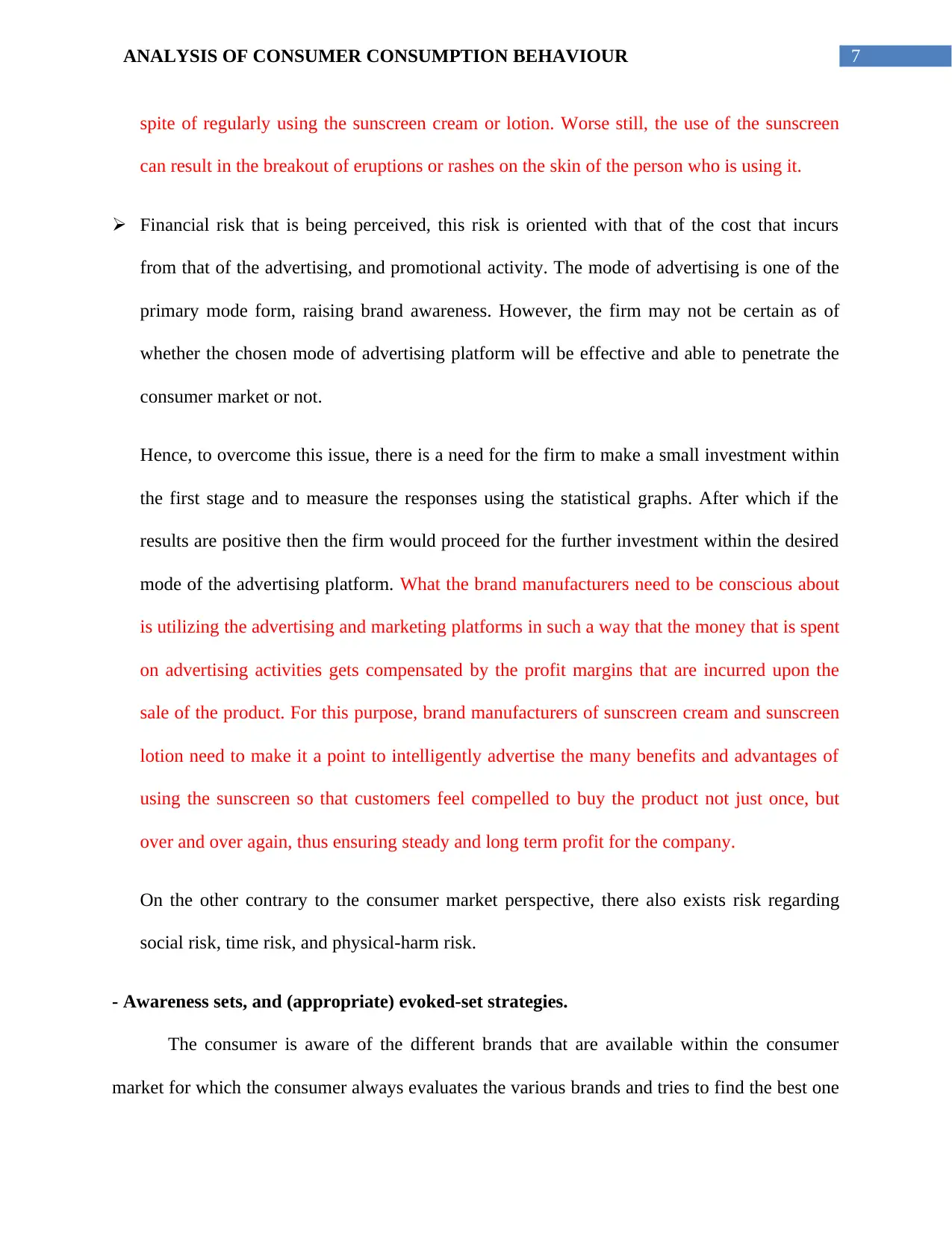
7ANALYSIS OF CONSUMER CONSUMPTION BEHAVIOUR
spite of regularly using the sunscreen cream or lotion. Worse still, the use of the sunscreen
can result in the breakout of eruptions or rashes on the skin of the person who is using it.
Financial risk that is being perceived, this risk is oriented with that of the cost that incurs
from that of the advertising, and promotional activity. The mode of advertising is one of the
primary mode form, raising brand awareness. However, the firm may not be certain as of
whether the chosen mode of advertising platform will be effective and able to penetrate the
consumer market or not.
Hence, to overcome this issue, there is a need for the firm to make a small investment within
the first stage and to measure the responses using the statistical graphs. After which if the
results are positive then the firm would proceed for the further investment within the desired
mode of the advertising platform. What the brand manufacturers need to be conscious about
is utilizing the advertising and marketing platforms in such a way that the money that is spent
on advertising activities gets compensated by the profit margins that are incurred upon the
sale of the product. For this purpose, brand manufacturers of sunscreen cream and sunscreen
lotion need to make it a point to intelligently advertise the many benefits and advantages of
using the sunscreen so that customers feel compelled to buy the product not just once, but
over and over again, thus ensuring steady and long term profit for the company.
On the other contrary to the consumer market perspective, there also exists risk regarding
social risk, time risk, and physical-harm risk.
- Awareness sets, and (appropriate) evoked-set strategies.
The consumer is aware of the different brands that are available within the consumer
market for which the consumer always evaluates the various brands and tries to find the best one
spite of regularly using the sunscreen cream or lotion. Worse still, the use of the sunscreen
can result in the breakout of eruptions or rashes on the skin of the person who is using it.
Financial risk that is being perceived, this risk is oriented with that of the cost that incurs
from that of the advertising, and promotional activity. The mode of advertising is one of the
primary mode form, raising brand awareness. However, the firm may not be certain as of
whether the chosen mode of advertising platform will be effective and able to penetrate the
consumer market or not.
Hence, to overcome this issue, there is a need for the firm to make a small investment within
the first stage and to measure the responses using the statistical graphs. After which if the
results are positive then the firm would proceed for the further investment within the desired
mode of the advertising platform. What the brand manufacturers need to be conscious about
is utilizing the advertising and marketing platforms in such a way that the money that is spent
on advertising activities gets compensated by the profit margins that are incurred upon the
sale of the product. For this purpose, brand manufacturers of sunscreen cream and sunscreen
lotion need to make it a point to intelligently advertise the many benefits and advantages of
using the sunscreen so that customers feel compelled to buy the product not just once, but
over and over again, thus ensuring steady and long term profit for the company.
On the other contrary to the consumer market perspective, there also exists risk regarding
social risk, time risk, and physical-harm risk.
- Awareness sets, and (appropriate) evoked-set strategies.
The consumer is aware of the different brands that are available within the consumer
market for which the consumer always evaluates the various brands and tries to find the best one

8ANALYSIS OF CONSUMER CONSUMPTION BEHAVIOUR
out of the various brands. The consumer gets attracted among two to three different brands and is
uncertain such that which brand to consume for which the consumer purchasing behaviour gets
affected.
On the other perspective, the consumer is aware of the set of benefits that will be gained
by making use of the rival brands and is confused to some extent regarding which of the brands
to purchase. Hence, sometimes, the awareness of the brand and its advantages also results in the
buying behaviour of the consumers.
- Dominant decision-making rules.
The price aspect – Customers will always feel tempted to buy a product that is affordably
priced compared to one that costs quite a bit of money. This is something that is especially
likely to be true for a product like sunscreen which is something that a customer is going to
make use of on a regular basis rather than just once in a while.
The quality aspect – Customers will always want to use products that give them value for the
money that they spend on the purchase of the product. For this to happen, the product that
they are using will have to be of a very high quality. With regard to sunscreen, it needs to be
safe for use and should also smell and feel good when used.
The design aspect – The sunscreen cream or lotion if packaged in a well-designed bottle or a
nicely designed container is one that is sure to attract the attention and the interest of
customers. If the product is poorly designed it will not have the visual appeal that is
necessary for drawing customer attention and interest over a prolonged period of time
The ingredient aspect – The ingredients with which the sunscreen cream or lotion is
manufactured need to ideally be natural in terms of composition so that these do not have a
dangerous or bad impact on the skin when it is used. The ingredients need to be of high
out of the various brands. The consumer gets attracted among two to three different brands and is
uncertain such that which brand to consume for which the consumer purchasing behaviour gets
affected.
On the other perspective, the consumer is aware of the set of benefits that will be gained
by making use of the rival brands and is confused to some extent regarding which of the brands
to purchase. Hence, sometimes, the awareness of the brand and its advantages also results in the
buying behaviour of the consumers.
- Dominant decision-making rules.
The price aspect – Customers will always feel tempted to buy a product that is affordably
priced compared to one that costs quite a bit of money. This is something that is especially
likely to be true for a product like sunscreen which is something that a customer is going to
make use of on a regular basis rather than just once in a while.
The quality aspect – Customers will always want to use products that give them value for the
money that they spend on the purchase of the product. For this to happen, the product that
they are using will have to be of a very high quality. With regard to sunscreen, it needs to be
safe for use and should also smell and feel good when used.
The design aspect – The sunscreen cream or lotion if packaged in a well-designed bottle or a
nicely designed container is one that is sure to attract the attention and the interest of
customers. If the product is poorly designed it will not have the visual appeal that is
necessary for drawing customer attention and interest over a prolonged period of time
The ingredient aspect – The ingredients with which the sunscreen cream or lotion is
manufactured need to ideally be natural in terms of composition so that these do not have a
dangerous or bad impact on the skin when it is used. The ingredients need to be of high
⊘ This is a preview!⊘
Do you want full access?
Subscribe today to unlock all pages.

Trusted by 1+ million students worldwide
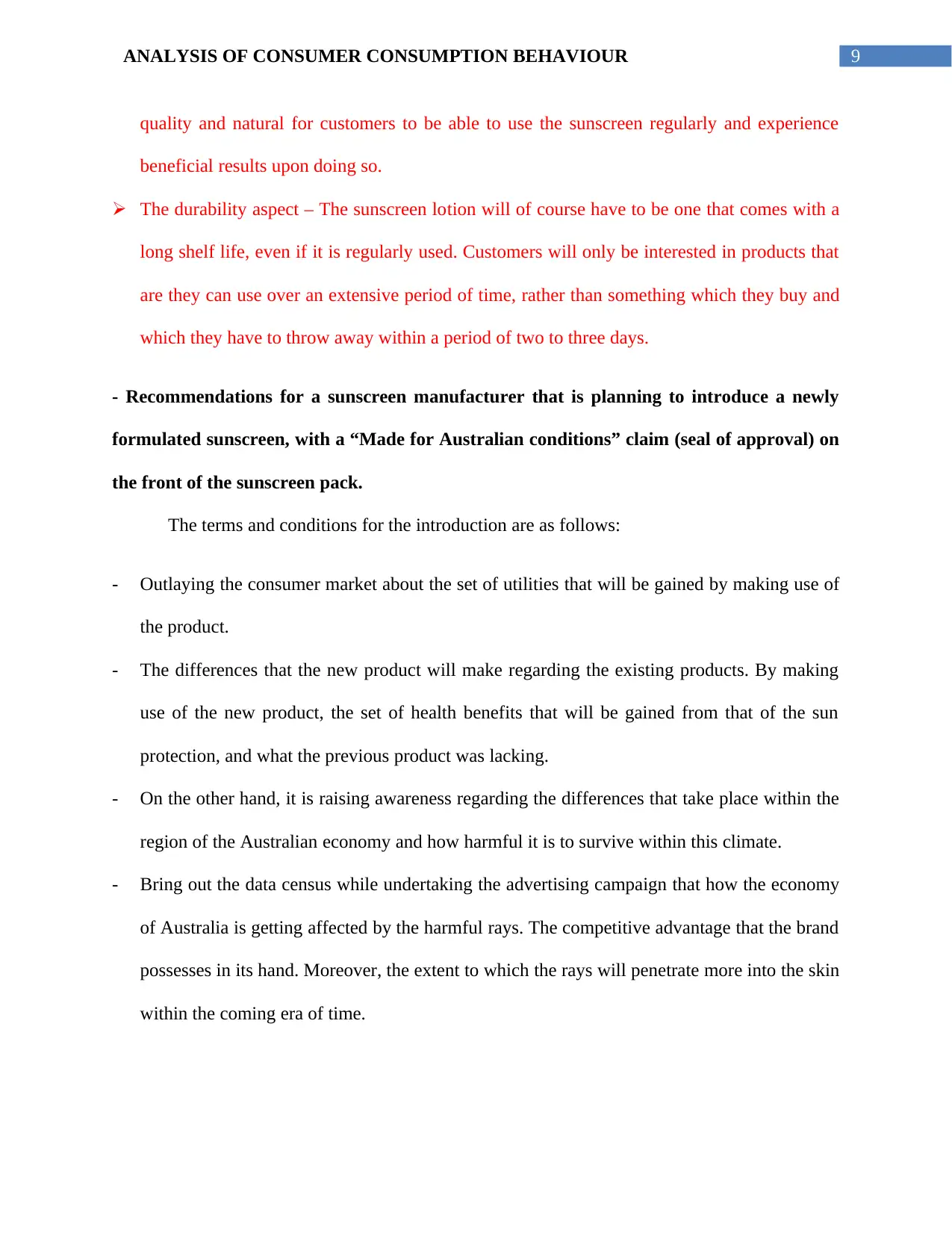
9ANALYSIS OF CONSUMER CONSUMPTION BEHAVIOUR
quality and natural for customers to be able to use the sunscreen regularly and experience
beneficial results upon doing so.
The durability aspect – The sunscreen lotion will of course have to be one that comes with a
long shelf life, even if it is regularly used. Customers will only be interested in products that
are they can use over an extensive period of time, rather than something which they buy and
which they have to throw away within a period of two to three days.
- Recommendations for a sunscreen manufacturer that is planning to introduce a newly
formulated sunscreen, with a “Made for Australian conditions” claim (seal of approval) on
the front of the sunscreen pack.
The terms and conditions for the introduction are as follows:
- Outlaying the consumer market about the set of utilities that will be gained by making use of
the product.
- The differences that the new product will make regarding the existing products. By making
use of the new product, the set of health benefits that will be gained from that of the sun
protection, and what the previous product was lacking.
- On the other hand, it is raising awareness regarding the differences that take place within the
region of the Australian economy and how harmful it is to survive within this climate.
- Bring out the data census while undertaking the advertising campaign that how the economy
of Australia is getting affected by the harmful rays. The competitive advantage that the brand
possesses in its hand. Moreover, the extent to which the rays will penetrate more into the skin
within the coming era of time.
quality and natural for customers to be able to use the sunscreen regularly and experience
beneficial results upon doing so.
The durability aspect – The sunscreen lotion will of course have to be one that comes with a
long shelf life, even if it is regularly used. Customers will only be interested in products that
are they can use over an extensive period of time, rather than something which they buy and
which they have to throw away within a period of two to three days.
- Recommendations for a sunscreen manufacturer that is planning to introduce a newly
formulated sunscreen, with a “Made for Australian conditions” claim (seal of approval) on
the front of the sunscreen pack.
The terms and conditions for the introduction are as follows:
- Outlaying the consumer market about the set of utilities that will be gained by making use of
the product.
- The differences that the new product will make regarding the existing products. By making
use of the new product, the set of health benefits that will be gained from that of the sun
protection, and what the previous product was lacking.
- On the other hand, it is raising awareness regarding the differences that take place within the
region of the Australian economy and how harmful it is to survive within this climate.
- Bring out the data census while undertaking the advertising campaign that how the economy
of Australia is getting affected by the harmful rays. The competitive advantage that the brand
possesses in its hand. Moreover, the extent to which the rays will penetrate more into the skin
within the coming era of time.
Paraphrase This Document
Need a fresh take? Get an instant paraphrase of this document with our AI Paraphraser
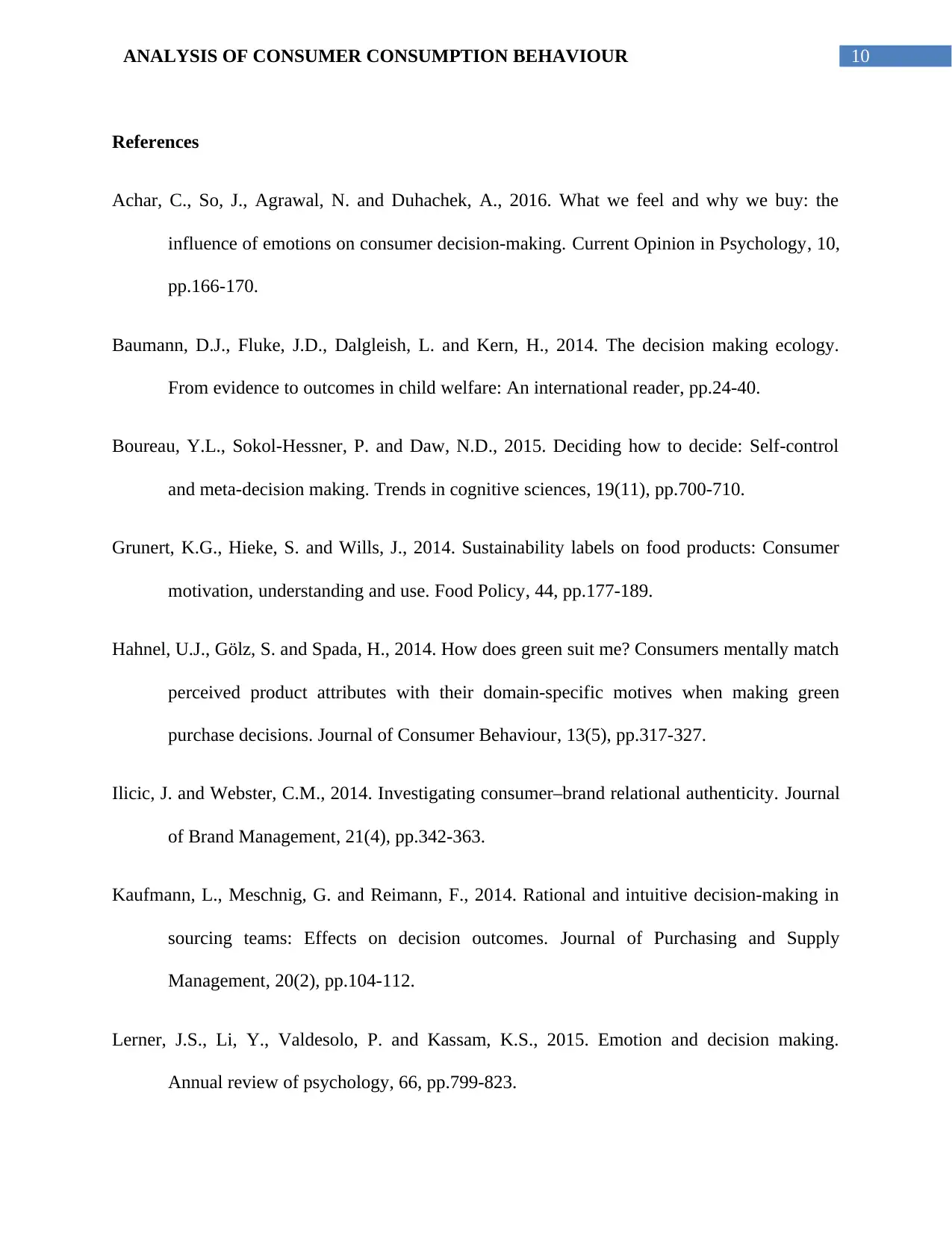
10ANALYSIS OF CONSUMER CONSUMPTION BEHAVIOUR
References
Achar, C., So, J., Agrawal, N. and Duhachek, A., 2016. What we feel and why we buy: the
influence of emotions on consumer decision-making. Current Opinion in Psychology, 10,
pp.166-170.
Baumann, D.J., Fluke, J.D., Dalgleish, L. and Kern, H., 2014. The decision making ecology.
From evidence to outcomes in child welfare: An international reader, pp.24-40.
Boureau, Y.L., Sokol-Hessner, P. and Daw, N.D., 2015. Deciding how to decide: Self-control
and meta-decision making. Trends in cognitive sciences, 19(11), pp.700-710.
Grunert, K.G., Hieke, S. and Wills, J., 2014. Sustainability labels on food products: Consumer
motivation, understanding and use. Food Policy, 44, pp.177-189.
Hahnel, U.J., Gölz, S. and Spada, H., 2014. How does green suit me? Consumers mentally match
perceived product attributes with their domain‐specific motives when making green
purchase decisions. Journal of Consumer Behaviour, 13(5), pp.317-327.
Ilicic, J. and Webster, C.M., 2014. Investigating consumer–brand relational authenticity. Journal
of Brand Management, 21(4), pp.342-363.
Kaufmann, L., Meschnig, G. and Reimann, F., 2014. Rational and intuitive decision-making in
sourcing teams: Effects on decision outcomes. Journal of Purchasing and Supply
Management, 20(2), pp.104-112.
Lerner, J.S., Li, Y., Valdesolo, P. and Kassam, K.S., 2015. Emotion and decision making.
Annual review of psychology, 66, pp.799-823.
References
Achar, C., So, J., Agrawal, N. and Duhachek, A., 2016. What we feel and why we buy: the
influence of emotions on consumer decision-making. Current Opinion in Psychology, 10,
pp.166-170.
Baumann, D.J., Fluke, J.D., Dalgleish, L. and Kern, H., 2014. The decision making ecology.
From evidence to outcomes in child welfare: An international reader, pp.24-40.
Boureau, Y.L., Sokol-Hessner, P. and Daw, N.D., 2015. Deciding how to decide: Self-control
and meta-decision making. Trends in cognitive sciences, 19(11), pp.700-710.
Grunert, K.G., Hieke, S. and Wills, J., 2014. Sustainability labels on food products: Consumer
motivation, understanding and use. Food Policy, 44, pp.177-189.
Hahnel, U.J., Gölz, S. and Spada, H., 2014. How does green suit me? Consumers mentally match
perceived product attributes with their domain‐specific motives when making green
purchase decisions. Journal of Consumer Behaviour, 13(5), pp.317-327.
Ilicic, J. and Webster, C.M., 2014. Investigating consumer–brand relational authenticity. Journal
of Brand Management, 21(4), pp.342-363.
Kaufmann, L., Meschnig, G. and Reimann, F., 2014. Rational and intuitive decision-making in
sourcing teams: Effects on decision outcomes. Journal of Purchasing and Supply
Management, 20(2), pp.104-112.
Lerner, J.S., Li, Y., Valdesolo, P. and Kassam, K.S., 2015. Emotion and decision making.
Annual review of psychology, 66, pp.799-823.
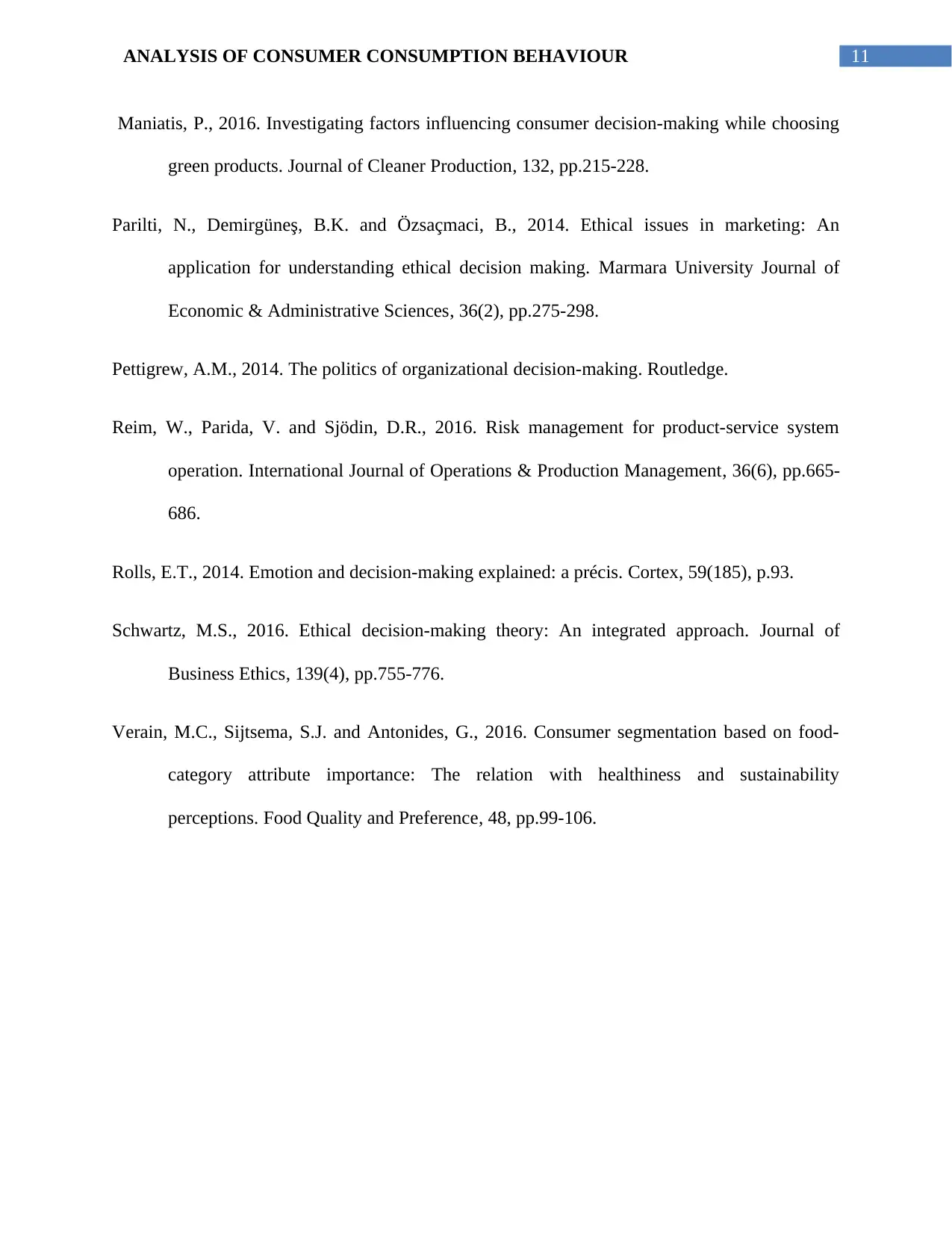
11ANALYSIS OF CONSUMER CONSUMPTION BEHAVIOUR
Maniatis, P., 2016. Investigating factors influencing consumer decision-making while choosing
green products. Journal of Cleaner Production, 132, pp.215-228.
Parilti, N., Demirgüneş, B.K. and Özsaçmaci, B., 2014. Ethical issues in marketing: An
application for understanding ethical decision making. Marmara University Journal of
Economic & Administrative Sciences, 36(2), pp.275-298.
Pettigrew, A.M., 2014. The politics of organizational decision-making. Routledge.
Reim, W., Parida, V. and Sjödin, D.R., 2016. Risk management for product-service system
operation. International Journal of Operations & Production Management, 36(6), pp.665-
686.
Rolls, E.T., 2014. Emotion and decision-making explained: a précis. Cortex, 59(185), p.93.
Schwartz, M.S., 2016. Ethical decision-making theory: An integrated approach. Journal of
Business Ethics, 139(4), pp.755-776.
Verain, M.C., Sijtsema, S.J. and Antonides, G., 2016. Consumer segmentation based on food-
category attribute importance: The relation with healthiness and sustainability
perceptions. Food Quality and Preference, 48, pp.99-106.
Maniatis, P., 2016. Investigating factors influencing consumer decision-making while choosing
green products. Journal of Cleaner Production, 132, pp.215-228.
Parilti, N., Demirgüneş, B.K. and Özsaçmaci, B., 2014. Ethical issues in marketing: An
application for understanding ethical decision making. Marmara University Journal of
Economic & Administrative Sciences, 36(2), pp.275-298.
Pettigrew, A.M., 2014. The politics of organizational decision-making. Routledge.
Reim, W., Parida, V. and Sjödin, D.R., 2016. Risk management for product-service system
operation. International Journal of Operations & Production Management, 36(6), pp.665-
686.
Rolls, E.T., 2014. Emotion and decision-making explained: a précis. Cortex, 59(185), p.93.
Schwartz, M.S., 2016. Ethical decision-making theory: An integrated approach. Journal of
Business Ethics, 139(4), pp.755-776.
Verain, M.C., Sijtsema, S.J. and Antonides, G., 2016. Consumer segmentation based on food-
category attribute importance: The relation with healthiness and sustainability
perceptions. Food Quality and Preference, 48, pp.99-106.
⊘ This is a preview!⊘
Do you want full access?
Subscribe today to unlock all pages.

Trusted by 1+ million students worldwide
1 out of 12
Related Documents
Your All-in-One AI-Powered Toolkit for Academic Success.
+13062052269
info@desklib.com
Available 24*7 on WhatsApp / Email
![[object Object]](/_next/static/media/star-bottom.7253800d.svg)
Unlock your academic potential
Copyright © 2020–2025 A2Z Services. All Rights Reserved. Developed and managed by ZUCOL.



